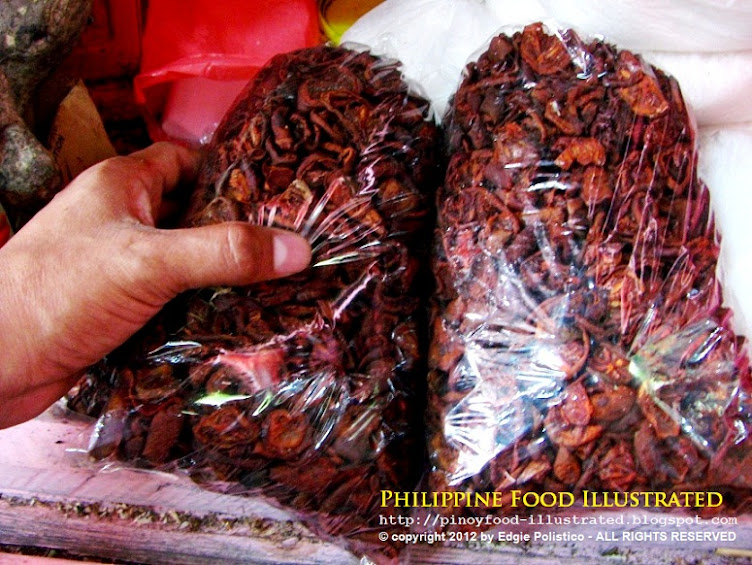
buy-o - /búy-o/ Sambali [Botolan, Zambales] condiment\seasoning) [n.] Botolan salt in woven nipa palm pouch.
Other local name:
- asin sa buy-o in Tagalog
Buy-o is originally the Sambali name for that cylindrical pouch that is made of woven nipa palm. This container is used to pack the raw sea salt produced in Botolan, Zambales. Thus, in Tagalog, the salt is called asin sa buy-o (salt in buy-o). The nipa palm (leaves) are cut off from the frond and the blades of the palm are sewn together in a pattern of overlapping each other side by side until they become a wide sheet. The sheet of sewn palms is rolled to shape and look like a cylindrical fat bottle. The circular frame or ring at the base is made of a palm frond. The strips used in stitching the palms could be thin strips of bamboo, rattan bark, or the bark of nipa frond.
The tip of the container is tapered to look like the mouth of PET bottles, folded and secured tightly with a strip. When the salt is needed, the topmost part of the pouch is cut off or loosened so as to open the container and allow access to the salt inside.
The floor at the base is made of latticed palm midribs or straw lined with a sheet of food-grade sack that allows the salt to breathe inside.
A handle is attached on the side that is made of a bent bamboo stick or hemp rope that loops upward.
The salt is produced by collecting sands that have been soaked for so long in the sea or seashore of Botolan. Sands on the seashore of Botolan that are always soaked in seawater on high tide are heavily saturated with salt deposits. The sands are collected when the sea is ebbing down to its lowest level. It is best to scoop sands at this moment as it would be a lot easier when they are not underwater. The sands can also be made saturated with salt by getting water from the Botolan sea and pouring it on a bed or mound of collected sand on the dry shore and then allowing the sand to dry under the sun. The pouring of seawater and sun drying is done over and over again the whole day at regular intervals until the sand is heavily saturated with salt. In between pouring and sun drying, the sand is turned over with a rake to evenly distribute the saturation of salt.
The collected sands are hauled into a large wooden funnel-shaped strainer and poured with the final round of seawater. The saline water that comes out down through the strainer is collected and boiled continuously in a boiler (usually a kawa, a big wide round cast-iron pan) until white crystals of salt are produced at the bottom of the boiler. When the boiler is about to get dry, more water from the strainer is added to the boiler so as to keep producing salt. The white crystals of sea salt produced are collected using a woven bamboo splits scooping basket that allows the salt to drip and dry. When dry, the salt is then packed in buy-o for keeping.
The buy-o salt is densely packed inside the palm pouch that after some time, it would harden and has to be scraped off when needed in cooking or for other uses.
Asin sa buy-o is the Tagalog name for this Botolan artisanal salt, and it means "salt in nipa palm pouch."
If you liked this post, share it.
Let us know your opinion on the subject. Feel free to comment in the comment section, below. It is important for us to know what you think.
Tell us what other topics you would like us to write, share, and discuss.
Related topic:
For more about Filipino food, see this Philippine Food, Cooking, and Dining Dictionary. It is OPEN and FREE.
You can also follow and learn more by joining us in our Facebook group.
Thank you for all the encouragement and enthusiasm. I need your moral support, prayers, and anything else that can uplift my spirit and keep my good reasons. Keep them coming.
Sharing is happiness to me. If you are pleased and happy with what you found here, please share the happiness we have in the PHILIPPINE FOOD ILLUSTRATED. I feel energized when it becomes part of the reasons why you are happy and smiling.
Click here on how else you can help me. Thank you for your kindness and support.
Edgie Polistico

.jpg)
.jpg)
.jpg)
.jpg)
.jpg)




